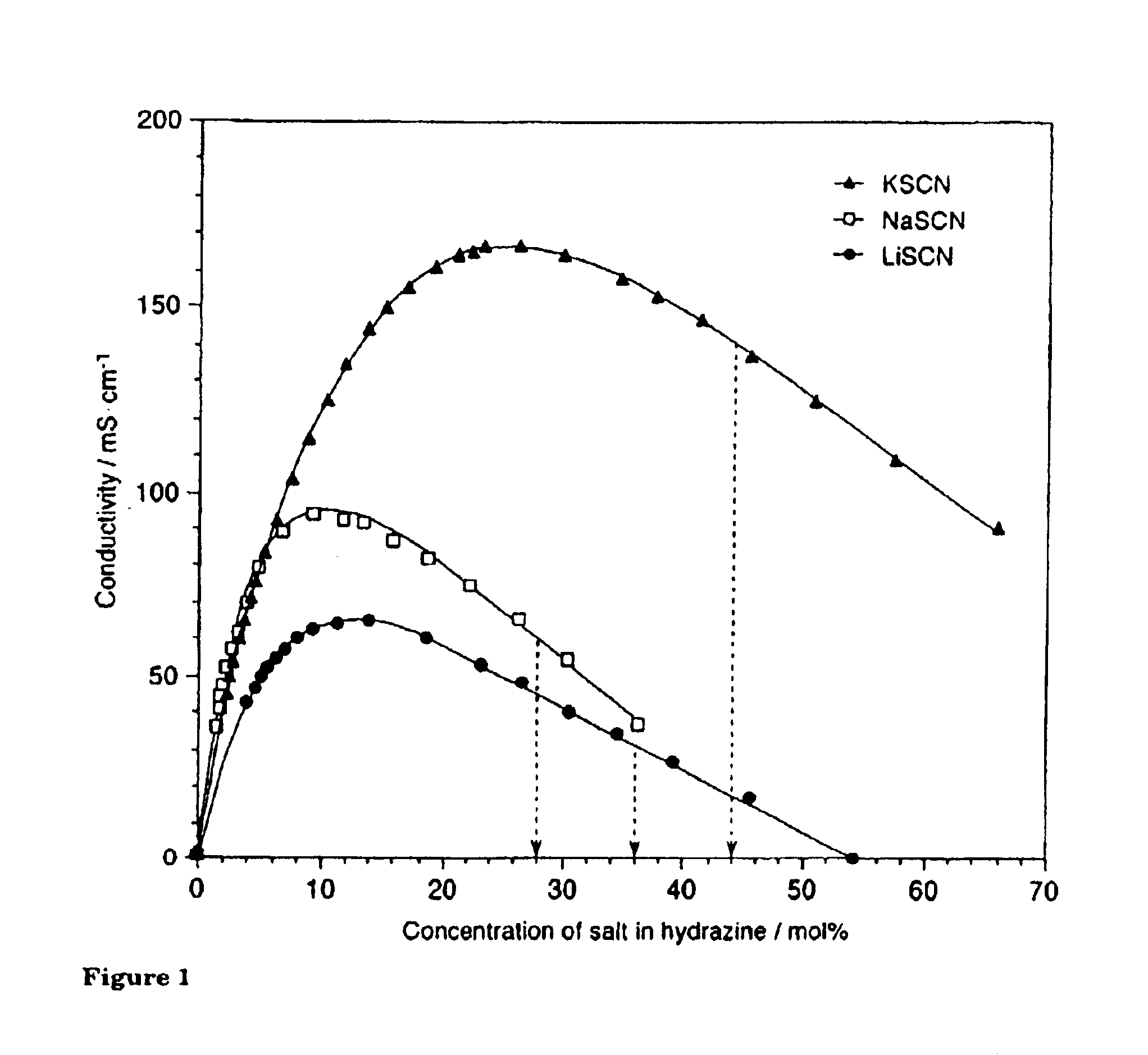Cellulose solvent compositions and methods of making and employing same
a technology of cellulose and composition, applied in the direction of adhesive types, coatings, printing, etc., can solve the problems of cellulose degradation, high cost, and difficult task of dissolving cellulose without chemical modification and/or derivatization, and achieve the effect of facilitating the dissolution of cellulos
- Summary
- Abstract
- Description
- Claims
- Application Information
AI Technical Summary
Benefits of technology
Problems solved by technology
Method used
Image
Examples
example 1
Results and Discussion For Example 1
Solubility Measurements of Cellulose I in Hydrazine / Salt System. Scherer (Scherer, P. C., J Am Chem Soc (1953) 53:4009-4013) discovered that five salts, NH.sub.4 SCN, NaSCN, NaNO.sub.3, NaI, and NH.sub.4 I in liquid ammonia were effective for dissolving cellulose, although NH.sub.4 I was ineffective for cellulose I. However, the Scherer data are lacking in quantitative detail because the boiling point of all the solvents are below 0.degree. C. except for NH.sub.3 / NH.sub.4 SCN. Hence, it is difficult to determine the accurate solubility of cellulose and other solution properties at ordinary ambient conditions. Many years later, the properties of the NH.sub.3 / NH.sub.4 SCN system were discussed in detail by Cuculo and Hudson. See e.g., Hudson, S. M., PhD Dissertation, Fiber and Polymer Science, School of Textiles, North Carolina State University, Raleigh, N.C., United States of America (1981).
Hydrazine has a boiling point of 113.5.degree. C., which...
example 2
III.B. Example 2
Hydrazine Hydrate / Thiocyanate Salt System
The handling of hydrazine hydrate requires fewer safety precautions in handling and provides a lower cost for use of in spinning, as compared to anhydrous hydrazine. Clarification of the dissolution mechanism and the influence of water on cellulose dissolving are also of interest from the point of view of scientific research and industrial application. This Example investigated the solubility of sodium thiocyanate in hydrazine monohydrate and its dissolution power for cellulose.
Experimental. Sodium thiocyanate was dried at 110.degree. C. overnight in a vacuum oven prior to use. Hydrazine monohydrate was obtained from Aldrich Chemical Company, St. Louis, Mo., United States of America, and used without any treatment. Cellulose I obtained from Whatman Bio Systems, Cellulose Powder CC41 with DP210 (M.sub.w 34,000), was dried at 60.degree. C. in a vacuum oven overnight and stored in a desiccator until its use.
In a 100 mL three-neck...
example 3
III.C. Example 3
Ethylenediamine / Thiocyanate Salt System
In this Example, the substitution of hydrazine to another amine, ethylenediamine, in the amine / thiocyanate solvent system was investigated.
Experimental. All chemicals used are ACS reagent grade. Sodium thiocyanate was dried at 110.degree. C. overnight in a vacuum oven prior to use. Anhydrous ethylenediamine was used directly without further purification. Cellulose obtained from Whatman Bio Systems, Cellulose Powder CC41 with DP210 (M.sub.w 34,000) and I polymorph, was dried at 60.degree. C. in a vacuum oven for 1 day and stored in a desiccator until its use.
In a 100 mL three-necked flask equipped with a magnetic stirrer-tip, connector to a nitrogen gas cylinder, and dropping funnel, NaSCN (9.35 g, 0.0123 mol) was dissolved in ethylenediamine (10 g, 0.166 mol) at room temperature under nitrogen atmosphere.
Cellulose powder (1.00 g) was placed in a polyethylene zip-lock bag (15 cm.times.10 cm). Ten grams of the solvent saturated sa...
PUM
| Property | Measurement | Unit |
|---|---|---|
| wt % | aaaaa | aaaaa |
| temperature | aaaaa | aaaaa |
| temperature | aaaaa | aaaaa |
Abstract
Description
Claims
Application Information
 Login to View More
Login to View More - R&D
- Intellectual Property
- Life Sciences
- Materials
- Tech Scout
- Unparalleled Data Quality
- Higher Quality Content
- 60% Fewer Hallucinations
Browse by: Latest US Patents, China's latest patents, Technical Efficacy Thesaurus, Application Domain, Technology Topic, Popular Technical Reports.
© 2025 PatSnap. All rights reserved.Legal|Privacy policy|Modern Slavery Act Transparency Statement|Sitemap|About US| Contact US: help@patsnap.com



